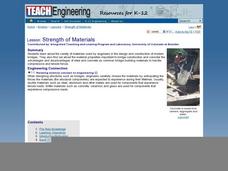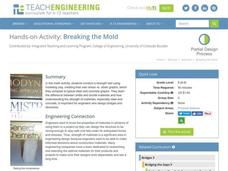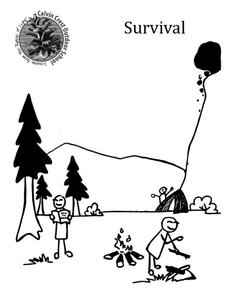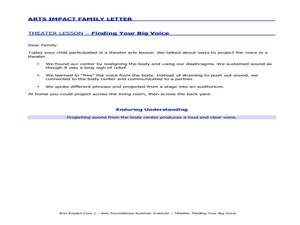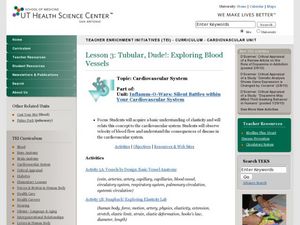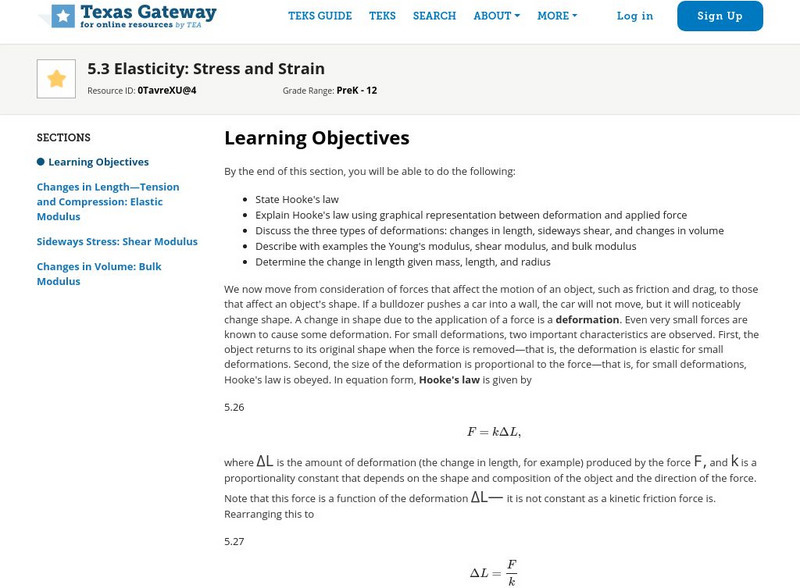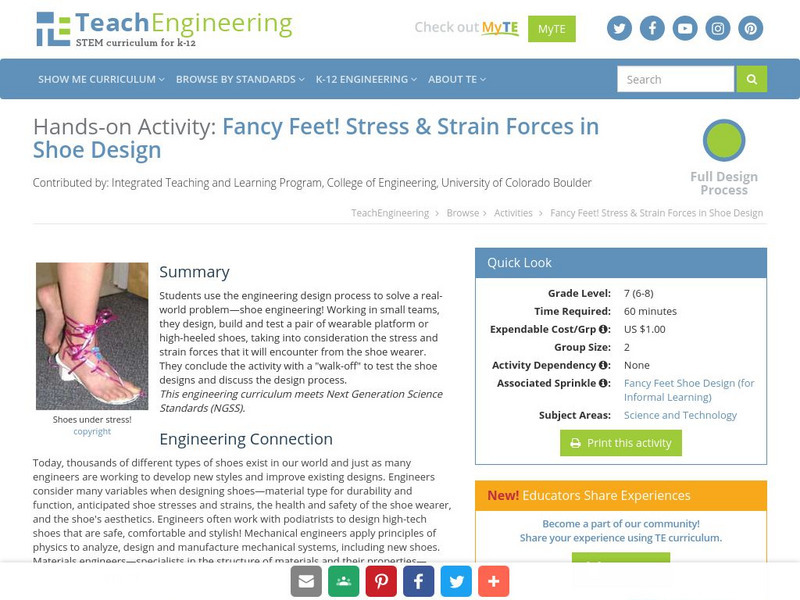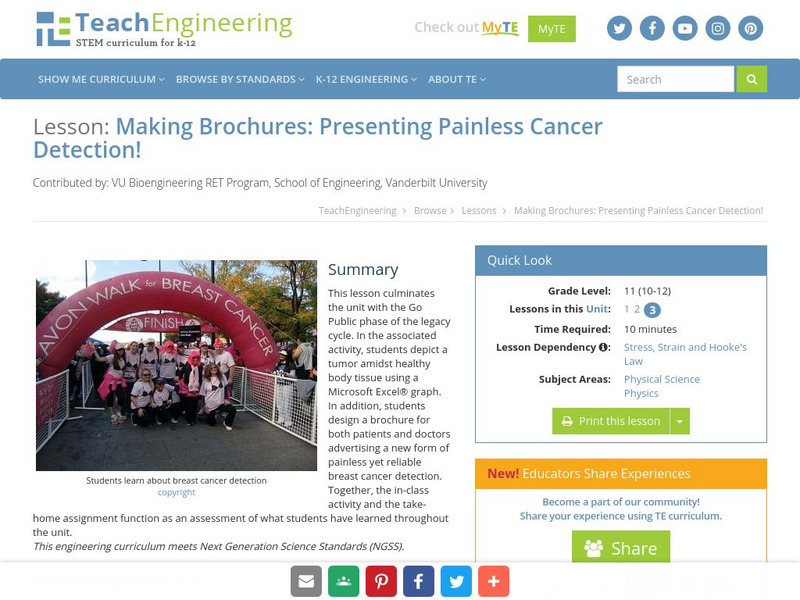Curated OER
Stressed and Strained
Pupils explore stress and strength in engineering design. In this engineering lesson, students become familiar with terminology associated with stress and strain on building material. They will have a class discuss about how their beam...
Teach Engineering
Strength of Materials
Pupils examine a stress-strain diagram that compares the advantages and disadvantages of the two common bridge building materials, concrete and steel. The also consider the factors that influence the materials builders choose for their...
Teach Engineering
Mechanics of Elastic Solids
Make the connection between Hooke's law and elasticity with an activity that introduces the class to the behavior of elastic materials. The resource defines stress and strain to calculate the modules of elasticity of...
Teach Engineering
Breaking the Mold
A little too much strain could cause a lot of stress. Groups conduct a strength test on clay. Using books as weights, pupils measure the compression of clay columns and calculate the associated strain and stress. Teams record their...
Curated OER
Stress and Strain
Students use working models to show the stress and strain in the movements in the earth's crust. In this stress lesson students complete a lab in which they construct a model.
Cornell University
Mechanical Properties of Gummy Worms
Learners won't have to squirm when asked the facts after completing an intriguing lab investigation! Hook young scholars on science by challenging them to verify Hooke's Law using a gummy worm. Measuring the length of the worm as they...
Curated OER
Building Bridges
Students, in groups, design and test a scale bridge. They use the Internet to research three basic bridge designs -- beam, arch, and suspension -- and the forces that act upon them.
Cornell University
The Physics of Bridges
Stability is key when building a bridge. Scholars explore the forces acting upon bridges through an analysis of Newton's Laws and Hooke's Law. The activity asks individuals to apply their learning by building a bridge of their own.
Curated OER
Changing Crust
For this changing crust worksheet, students use candy bars, licorice sticks and bubble gum to simulate the 3 types of forces that change the Earth's crust. These include compressional forces, tensional forces and transversal forces. The...
Curated OER
Breaking Beams
Pupils work together designing and building their own beams. They discover the concepts of stress and strain. They participate in a competition to determine the best beam.
Curated OER
Wind Effects on Model Building: Lab for Deflection and Moment of Inertia
Students investigate the relationship between shape of object and moment of inertia. In this physics lesson plan, students collect data from the experiment and use spreadsheet to graph them. They discuss how load affects deflection.
Calvin Crest Outdoor School
Survival
Equip young campers with important survival knowledge with a set of engaging lessons. Teammates work together to complete three outdoor activities, which include building a shelter, starting a campfire, and finding directions in the...
Curated OER
Finding Your Big Voice
Pupils use their diaphragm to create vocal vibrations, vocal sounds, and project sounds through an open space. In this sounds lesson plan, students learn how to use their voices to project through an auditorium.
Curated OER
Plate Tectonics
Students identify that most of mountain ranges found on all major land masses and in the oceans are external reflections of tectonic movements within the earth. They identify that earthquakes and related phenomena are caused by the...
Curated OER
Tubular, Dude! Exploring Blood Vessels
Students explore the cardiovascular system. In this human body lesson, students observe blood flow and study cardiovascular diseases and how they affect the human body system.
Curated OER
Design & Technology: Materials Strength
Pupils investigate the function of a floor stretcher and some of the past designs. The goal is to improve the design durability and ease of use. Then they sketch their ideas and write a rationale for changes made to the structure.
Texas Education Agency
Texas Gateway: Further Applications of Newton's: Elasticity: Stress and Strain
By the end of this section, you will be able to state Hooke's law; explain Hook's law using graphical representations between deformation and applied force; discuss the three types of deformations: changes in length, sideways shear, and...
OpenStax
Open Stax: Elasticity: Stress and Strain
In the following interactive students will learn about Hooke's Law. They will explain this law using graphical representation between deformation and applied force and discuss the three types of deformations such as changes in length,...
TeachEngineering
Teach Engineering: Stressed and Strained
Learners are introduced to the concepts of stress and strain with examples that illustrate the characteristics and importance of these forces in our everyday lives. They explore the factors that affect stress, why engineers need to know...
TeachEngineering
Teach Engineering: Fancy Feet
Students use the engineering design process to solve a real-world problem - shoe engineering! Working in small teams, students design, build and test a pair of wearable platform or high-heeled shoes, taking into consideration the stress...
TeachEngineering
Teach Engineering: Presenting Painless Breast Cancer Detection!
This lesson culminates the unit with the Go Public phase of the legacy cycle. In the associated activity, young scholars must depict a tumor amidst healthy body tissue using a graph in Microsoft Excel. In addition, students will design a...
Johns Hopkins University
Johns Hopkins University: Properties of Solids
From the General Physics for Bio-Science Majors web site. Several properties of solids, many of which pertain to the elasticity of materials. Stress and strain are defined and Young's modulus is explained. The Young's modulus equation is...
Texas Education Agency
Texas Gateway: 5 Newton's Laws: Friction, Drag, and Elasticity: Summary
This page summarizes each section of Chapter 5: Further Applications of Newton's Laws: Friction, Drag, and Elasticity from the AP Physics online text. These include friction, drag force, and elasticity: stress and strain.

